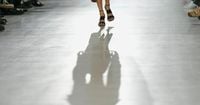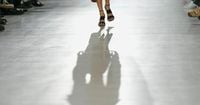Max Mara’s Spring 2026 Ready-to-Wear Collection took center stage at Milan Fashion Week on September 25, 2025, unveiling a vision that was equal parts audacious and poetic. With the world’s fashion eyes trained on Milan, creative director Ian Griffiths delivered a show that wove together the opulence of 18th-century French Rococo, the cool edge of modern power dressing, and a dash of playful escapism. The result? A collection that was both a nod to history and a wink at the future, sparking conversation and admiration in equal measure.
According to WWD, the backbone of the collection was the power suit, but with a twist: Griffiths upped the ante on sensuality, showing off lots of skin and flirting with a touch of fetishism. Pencil skirts and trousers, cut from stretch jersey, hugged the body and were paired with cropped knitwear that revealed belts accentuating bare midriffs. "The theme for Max Mara this season is lightness and strength, and capriciousness and playfulness. Playfulness with power," Griffiths told the Associated Press. "I think everyone is looking for a little bit of escapism and poetry in their clothes right now."
This sense of escapism was apparent from the very first look. As Bustle described, the show opened with a classic double-breasted trench, but with sleeves replaced by intricately folded coronas at the shoulders—a sculptural flourish that seemed to channel the scroll-like volutes of Rococo architecture. Streamlined outerwear was paired with organza miniskirts, each crafted from hundreds of cut and folded pieces. Voluminous, gauzy crests sprouted from sleek pencil skirts, while delicate wisps of organza drifted freely from otherwise strict tailoring. The effect was one of extravagant minimalism, where Max Mara’s signature clean lines met the drama of the 18th century.
The historical reference point for the collection was Madame de Pompadour, the legendary maîtresse-en-titre of Louis XV and a celebrated patron of the arts. Griffiths, as noted by Bustle, cited her as his muse for the season—a fitting choice for a brand that has long celebrated exceptional women. Madame de Pompadour, who rose from bourgeois origins to become a central figure in the French court, was known for her wit, style, and influence, not to mention her deep involvement in the world of ballet. The collection paid homage to her legacy with ballet-core-inflected pieces: feather-light wrap sweaters, boatneck coats reminiscent of long-sleeve leotards, and models’ hair swept into elegant chignons, secured with thin elastic dance headbands. Black hip-alignment elastics—typically used by dancers to check their posture—were reimagined as accessories, worn over blazers, backless dresses, and even directly on toned abs, à la Carrie Bradshaw.
But this was no mere costume drama. The soundtrack, curated by DJ Johnny Dynell, remixed chamber music with club beats, setting a tone that was both nostalgic and undeniably modern. The collection’s color palette furthered this duality: Max Mara’s trademark camel and black monochromes dominated, but there was also a single print featuring faded rococo shell and coral images, a subtle nod to the era’s decorative arts. According to AP, wide-legged palazzo pants made a cameo, offering a breezy counterpoint to the otherwise slim and sexy silhouettes.
Griffiths’ pursuit of lightness, he explained, was a direct response to the world’s current climate—both literally and figuratively. "My pursuit of lightness was a response to both rising global temperatures and tensions," he told AP. In a time marked by uncertainty and unrest, the collection’s airy fabrics and playful details offered a kind of sartorial escapism. Leaf-shaped organza cutouts, tailored into fluttery skirts and jackets (both long and short), whispered down the runway, their movement suggesting freedom and whimsy. Soft volumes, created from organza and technical mesh, enhanced shoulders and hips with a twirling ruffle effect, lending a sense of capriciousness and joy to the proceedings.
The front row was as starry as the runway itself. Thai actress Peraya Malisorn turned heads in a belted black ensemble, while Spanish actress Paz Vega opted for a gray double-breasted men’s tailored suit—both looks that underscored the collection’s blend of strength and sensuality. Their presence signaled Max Mara’s continued resonance with international tastemakers and celebrities, a testament to the brand’s enduring appeal.
Despite the collection’s flirtation with fetishistic elements—belts slung low over bare skin, cropped knits, and body-conscious jersey—there was nothing heavy-handed or overtly provocative about the presentation. Instead, the effect was one of confidence and ease, a reminder that power dressing can be both playful and empowering. As WWD pointed out, even the most formal and elegant looks were imbued with a sense of British cheekiness, a wink at tradition rather than a slavish adherence to it.
Of course, no Max Mara show would be complete without its signature outerwear. This season’s coats and trenches, while rooted in the house’s storied history, were anything but staid. The aforementioned trench with corona sleeves was joined by boatneck coats and other streamlined pieces, all rendered in feather-light materials that seemed to float down the runway. The overall mood was one of lightness, both literal and metaphorical—a fitting antidote to the weight of the current moment.
The collection’s success lay in its ability to balance contrasts: historical and modern, strict and playful, powerful and delicate. By drawing on the legacy of Madame de Pompadour and the aesthetics of Rococo, Griffiths managed to create clothes that felt both timeless and timely. As he told AP, "Everyone is looking for a little bit of escapism and poetry in their clothes right now." Judging by the rapt attention of the Milan Fashion Week audience, he delivered just that.
In a season where many designers are searching for new ways to capture the imagination, Max Mara’s Spring 2026 Ready-to-Wear Collection stood out for its intelligence, wit, and sheer beauty. Whether it was the intricate organza ruffles, the bold power suits, or the playful ballet-inspired details, every piece on the runway seemed to invite the wearer—and the viewer—to dream a little bigger, and to dress with both strength and joy.
As the final model disappeared backstage and the applause echoed through the venue, it was clear: Max Mara had once again proven that fashion can be both a refuge and a revelation, offering not just clothes, but a vision of the world as it could be—lighter, freer, and infinitely more beautiful.






